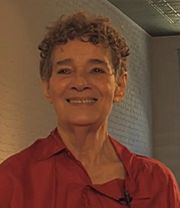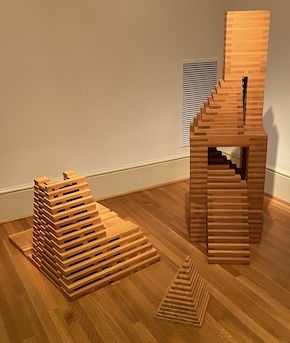Jackie Ferrara facts for kids
Quick facts for kids
Jackie Ferrara
|
|
|---|---|

Ferrara in 2012
|
|
| Born |
Jacqueline Hirschhorn
November 17, 1929 Detroit, Michigan, United States
|
| Died | October 22, 2025 (aged 95) Basel, Switzerland
|
| Education | Michigan State University |
| Known for | Sculpture |
| Movement | Postminimalism |
Jackie Ferrara, born Jacqueline Hirschhorn on November 17, 1929, was an important American artist. She passed away on October 22, 2025. She was best known for her unique sculptures that looked like stacked pyramids or steps. Her artwork can be found in many famous places. These include the Museum of Modern Art and the Los Angeles County Museum of Art. A well-known art critic, Peter Schjeldahl, once called her "one of our most talented and creative sculptors."
Contents
Who Was Jackie Ferrara?
Jackie Ferrara was a sculptor and a draftswoman. This means she created art by shaping materials and also made detailed drawings. Her art style is often linked to Postminimalism. This was an art movement that came after Minimalism. Artists in this movement often used simple shapes and everyday materials.
Her Early Life and Art Journey
Jackie Ferrara was born in Detroit, Michigan. This was on November 17, 1929. She studied at Michigan State University for about six months in 1950. However, she didn't have much formal art school training. In 1952, she moved to New York City. There, she became part of the city's exciting art world.
She worked for a short time at the Henry Street Playhouse. This led her to get involved with theater and dance. During the 1960s, Ferrara took part in art performances and events. These often happened at the Judson Memorial Church. She even performed in some art events by another artist, Claes Oldenburg. In 1973, she helped design the sets for a play.
During this time, she also started making sculptures. Her early sculptures were similar to a style called Minimalism. But by the 1970s, she developed her own special way of creating art. Her first sculptures included wax figures and interesting boxes. She also made hanging art pieces from materials like jute and canvas.
Exploring Her Unique Sculptures
Jackie Ferrara had her first solo art shows in New York in 1973 and 1974. These shows helped define her main style of sculpture.
Pyramids and Stepped Designs
Her 1973 show featured layered, simple sculptures. They looked like cubes, stairs, tall pillars, or pyramids. These artworks ranged from about 0.6 to 2.7 meters tall. She made the pieces from wood or cardboard. Sometimes, she covered them with soft cotton.

In her next show, Ferrara used only bare wood. She either nailed or glued the pieces together. This made her art look very clear and precise. It showed a strong sense of math and order in her designs. Her works were "pyramids" of different kinds. They had stepped walls and sometimes curved sides. Even though they looked like ancient pyramids, Jackie Ferrara saw them as abstract art. They were not just models of real buildings.
Her art often featured wooden pyramids or ziggurats (stepped towers). These had carefully stacked steps. Her work showed amazing craftsmanship. It also reminded people of ancient buildings from places like Mesoamerica and Egypt. She loved using geometric shapes. She also tried cutting parts away. She made pyramids that didn't always have four identical sides. Jackie Ferrara often made drawings on graph paper. These drawings helped her plan her detailed sculptures. One of her early important works was "Hollow Core Pyramid" from 1974. Other well-known works from this time include "Curved Pyramid" and "Stacked Pyramid," both from 1973.
Smaller Works and Outdoor Art
In the 1980s, Ferrara started making smaller artworks. These were made of plywood. She called them "wallyards" or "courtyards." They looked like tiny models of buildings rather than finished sculptures. She made these works more complex by using different types of wood. She also experimented with various stains.
These small works looked like models for bigger outdoor art. They had flat bases, walls, and sometimes stairs. They often featured geometric patterns that matched on different parts. She first used two shades of plywood for her "wallyards." Then, in 1982, she began using wood stains. She chose black, red, and yellow. She diluted them so you could still see the wood's natural grain. Using colors helped her create more complex patterns and shapes. For example, in her work Wall Set/Yellow (1983), she used different woods like pine and poplar. This added to its interesting design.
Another series of small works grew from these. Ferrara called them "places." Many of these looked like tiny temples. They seemed to be from ancient times, modern times, and even the future all at once.
Starting in the 1980s, Jackie Ferrara began creating art for outdoor spaces. These were often special commissions. Her "public environments" in the 1980s and 1990s focused on surfaces. These included floors, paths, and platforms. She arranged geometric patterns using tiles. She liked materials such as granite, slate, and terracotta. She created designs with checkerboards, triangles, and bands that moved in interesting ways.
Public Artworks You Can See
Jackie Ferrara created many large artworks for public spaces. These include "Castle Clinton: Tower and Bridge" (1979). Another was "Meeting Place" (1989). This piece had a large area with concrete and steel floors. It also featured a raised platform with steps and seating made of concrete and steel. In 1988, she created "Belvedere" at the Minneapolis Sculpture Garden.
Other public works include the 200-seat "Amphitheater" (1999) at LACMA. She also created the sixty-foot-high "Stepped Tower" (2000) at the University of Minnesota. Another notable work is the 60-foot-long red and black granite "Fountain" (2006) at University of Houston.
Awards and Recognition
Jackie Ferrara received many awards and grants for her artistic achievements:
- Creative Artists Public Service grants from the New York State Council on the Arts in 1971 and 1975.
- National Endowment for the Arts grants in 1973, 1977, and 1987.
- A Guggenheim Fellowship in 1975.
- The Design Excellence Award for Flushing Bay Promenade in Queens, New York City, in 1988. This was from the Art Commission of the City of New York.
- An Institute Honor from the American Institute of Architects in 1990.
- The Tucker Award for Design Excellence in 2001.
Personal Life
Jackie Ferrara married jazz musician Don Ferrara in 1955. They separated in 1957. She lived in Tuscany, Italy, for a time in 1959 and 1960. Jackie Ferrara passed away in Basel, Switzerland, on October 22, 2025, at the age of 95.

